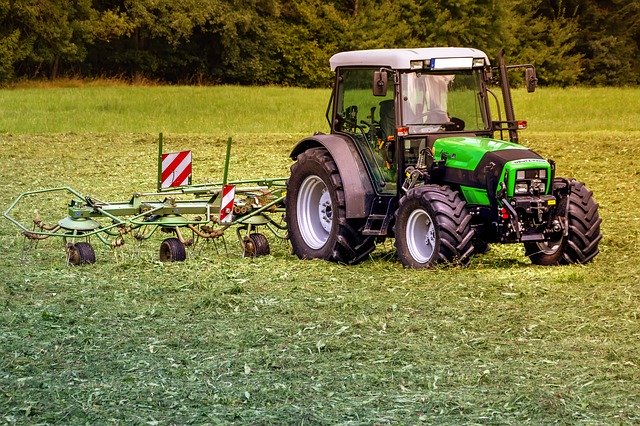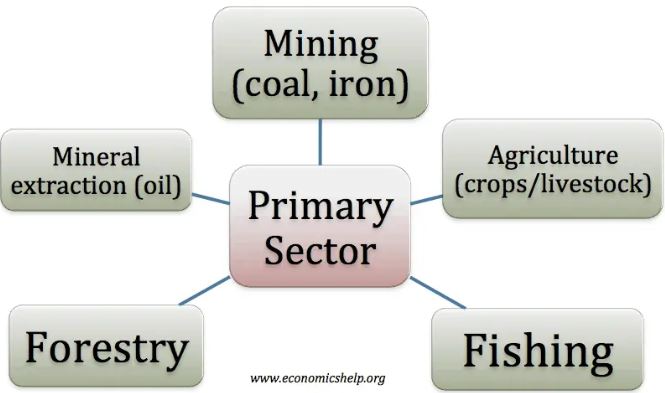
Primary industry, within the geographical context, relates to the extraction of raw materials from the sea or land. Some relate to fishing, forestry, agriculture, mining, or oil. The extraction of these core materials plays a key role to reach overall sustainability. It also ensures the survival of humankind through the use of these different resources.
Some resources allow us access to food, while others provide us with the ability to stay warm or keep our cars running. The extraction of primary resources became an important global discussion because many of our resources experience threats. These threats include, for example, the extinction of our fishing communities, a decline in oil resources, and finding new ways of preventing pollution.
The extraction industry relies significantly on the availability of resources directly from our planet. If we impact the availability of these resources, it creates diverse problems from a macro to a micro-level.
Primary industry plays a key role in the daily survival efforts of humankind, the support to poor communities, and the continuous development of a balanced lifestyle. Many communities rely on primary industries to access income, food, and energy to keep warm. This sector remains one of the key industries globally. Before we discuss the impacts of our activities on primary industry, let us see what the concept means.
What are Primary Industries?
Primary industries are normally based on the basic principles of produce or production processes, meaning they involve the extraction of original or raw material. As mentioned before, it relates to the mining sector for example during the extraction of iron ore. These resources play a key role in feeding secondary industries and allow for the further refinement of resources. The determination of the values normally aligns directly with the minerals.
For us to grasp the meaning of an industry, we need to understand what the term means. An industry relates to a group of organisations that mainly take part in the manufacturing or production of specific products or services. Primary industries do not necessarily provide a service but focus more on the extraction of natural resources.
What types of Primary Industries exist?

The primary industry plays a key role to start and maintain the economy of the world and countries. The industries focus on the production of raw materials by human intervention during the production phase. In the extractive industry, one cannot cultivate the material. This is different when looking at agriculture or crop growing activities.
Primary industries come in many shapes and sizes. Some industries, for example, fisheries offer small-scale communities and large industrial fishing activities. Other examples relate to the planting of trees and logging. Industries often rely on local forestry businesses to provide them with trees, in other instances, corporate companies plant them on a large-scale basis.
What are the characteristics of Primary Industries?
The role of the primary industries has transformed, especially in developed countries. Agricultural industries, for example, have become more technology orientated than traditional methods of planting or picking. In some developed countries, the use of insecticides plays a key role to ensure higher production. The negative side of following a more technical approach relates to a smaller workforce.
Another approach by developed countries is to use primary industries to enhance their wealth systems. The European Union attempts to align its inflation rates with the production of agricultural products, for example. It makes the market exceptionally competitive.
Governments aim to keep primary industry costs reasonable and protected from external influences. In the past and present, these industries struggled with extensive impacts during war or famine, which led to large-scale communities living without food for example. It, therefore, remains critical to keep a balance when impacting countries that rely on primary industries.
What are the Primary Industry Roles?
The primary industry exists for many reasons and aligns significantly with how a country manages its economic status. Developing companies focus more on primary industries than developed countries. Let us see the main aspects and challenges the industry comprises:
Export Returns use natural resources to collect income and export profits. For example, the selling of natural gas or oil allows for extensive economic growth in developing countries. It allowed them to collect capital and invest their funds in different infrastructure developments. Successful countries, in this case, relate to Saudi Arabia for example. Russia also displays an example of a country that supplies the West with natural gas.
In other countries, the export of prime industry minerals presented a more negative effect. In Africa, for example, significant mining by external companies happened with a limited progressive impact on the local economies. Meaning a limited portion of the profits returned to the communities impacted by the mining developments.
Primary industries continue to experience significant price differences because of their sensitive nature and unpredictability. Many times we see an increase in gas or petrol rates because of a change in oil prices.
Other characteristics related to a significant emphasis on the primary sector without developing the secondary part. Countries, therefore, rely on their primary industries and stay behind in large-scale technological developments.
The primary industry creates significant employment opportunities for individuals in the mining, agriculture, fishing, and forestry sectors. If a decline happens, it impacts their ability to keep the economy from moving into a recession. Apart from the issues related to the workforce, sometimes the oversupply of certain materials, for example, iron ore impacts the price. In the event of experiencing too much of a specific mineral, the share prices drop, and with this, keep the industries sustainable.
Frequently Asked Questions
What are the main sectors in the Primary Industry environment?
The primary industry environment focuses on the extracting sectors for example mining but also other types, including fishing, forestry, and agriculture.
Is the Primary Industry typical of a developing or developed country?
Primary industry occurs in developing and developed countries. Mostly the developed countries rely more on technologically advanced methods to manage the activities within the primary industry and become less work-intensive. Developing countries rely on a larger workforce to maintain their agricultural environment.
What are the effects of the Primary Industry on the economy of a country?
In most circumstances, the primary industries tend to display a more volatile status in developing than developed countries. The industry plays a significant role in maintaining the economy of a country, but with different variations. Mostly during a decline in the primary industry in a developing country, the economic impacts seem a lot more extensive. This relates to their reliance on this industry instead of secondary activities.
Can we live without the Primary Industry?
Although some countries became more advanced in the fields of Secondary Industries, it remains a critical part of any economy. Globally, scientists aim to find methods that allow the development of alternative food and energy resources. Still, humankind needs primary industries to create food and energy for survival.
Is the Primary Industry experiencing threats?
Globally the primary industry experiences threats from overpopulation, famine, war, or political instability. This industry stays significantly sensitive to any internal or external influences.
Read more about the Classification of Industry
Frequently Asked Questions
What is the main focus of primary industries?
Primary industries involve the extraction and collection of natural resources directly from the environment, such as agriculture, fishing, forestry, and mining.
How does agriculture contribute to the primary industry sector?
Agriculture involves cultivating crops, raising livestock, and producing food, fiber, and other raw materials for consumption and processing.
Mining is a primary industry that involves extracting minerals, metals, and fossil fuels from the Earth’s crust for various uses.
What role does fishing play in the primary industry sector?
Fishing is a primary industry that involves catching fish and other aquatic organisms for food, commercial sale, and recreational purposes.
How does deforestation relate to the primary industry sector?
Deforestation, often for logging purposes, is a primary industry activity that involves the extraction of timber and wood products from forests.
References
- https://www.britannica.com/topic/primary-industry
- https://www.economicshelp.org/concepts/primary-sector/
- Almeida, A.N. & Da Silva, João Carlos & Angelo, Humberto. (2013). Importance of primary, secondary and tertiary industries for sustainable development. 9. 146-162.





